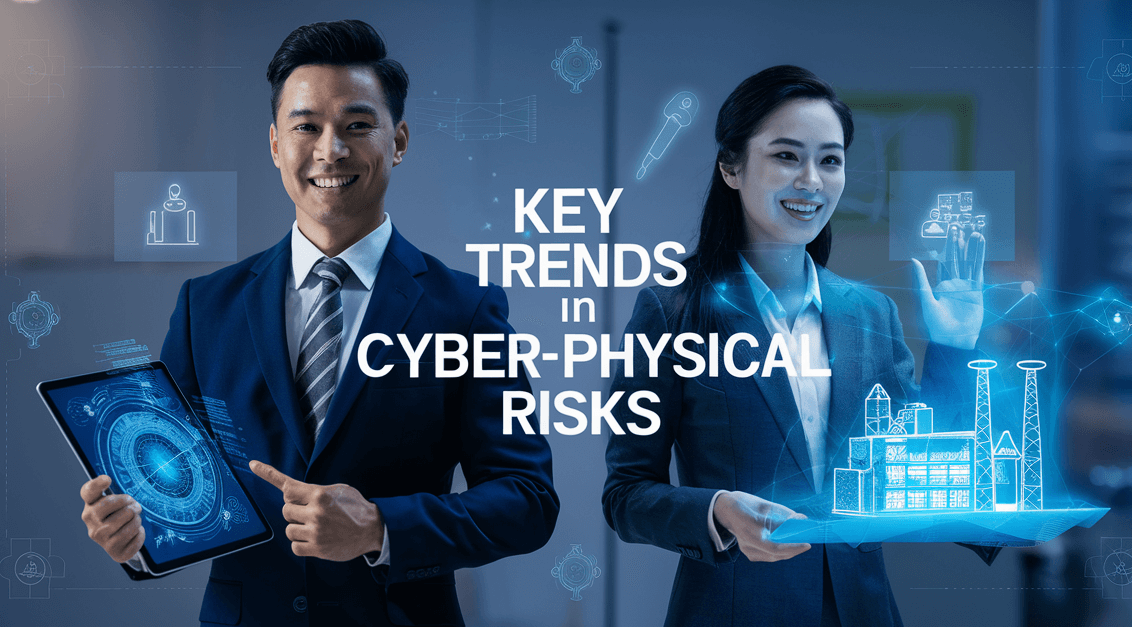Cyber-Physical Systems (CPS) combine computers and physical objects to create systems where the digital and physical worlds work together seamlessly. CPS is already extending to smart grids, smart homes, and self-driving cars, turning the world into a more coupled cyber twin simulation. This growing interdependence, however, brings forth a new set of challenges, including the outlined risks pertaining to cyber-physical risks. Cyber and physical risks are increasingly integrating, and this requires entities to address new risk challenges that are severe to organizational operations and structures.

Jump ahead to
The Evolving Threat Landscape
The Perfect Storm: Convergence of Cyber and Physical Threats
With usage of internet and computer systems becoming normal in people’s lives, distinctions between cyberspace and physical environment are becoming more and more frail. Performing phishing attacks and making them purely online can now lead to severe and even fatal consequences in the real world. Whilst cyber threats are on the rise, nature is more complex and refined, involving core establishments such as power and electricity, transport, and health. These may result in such threats as physical harm, loss of property, and sometimes even death.
The relatively new Internet of Things (IoT) has dramatically expanded the number of potential entry points. Applied to appliances and electronics that range from houses to industrial control systems, these devices can be hacked since they are very often not protected against cyberattacks. This will let the adversaries gain access to and control over these devices. Security issues related to IoT devices can be used as a foothold for more significant attacks. This can affect infrastructure and become a cause of a large-scale disaster.
Supply Chain Vulnerabilities: A Weak Link in the Chain
New generation supply chain networks, which are crucial for contemporary economics, are seen to be aggravated by cyber-physical threats. Incorporation of these chains implies that a break in one aspect can affect other aspects tremendously. Some of the impacts of cyber risks affecting any element of supply chain include slow production, no supply of products, business losses, and customer erosion of confidence.
To address these risks, it is important for organizations to focus on supply chain visibility and supply chain robustness. Developing good relations with suppliers, conducting security evaluations periodically, and deploying stringent security measures help prevent threats to supply chain risk.
Emerging Cyber-Physical Risk Trends –
The Rise of Ransomware: Beyond Data Encryption
Ransomware has developed from initially locking data to attacking essential facilities, which may have disastrous outcomes. Hackers are attacking hospitals, power stations, and transport companies, threatening to bring networks down for good unless they are paid large sums of money to return access. Neglect causes physical destruction, death, and suffering, in addition to the displacement of large populations.
Another factor that has worsened threat is concept of “double extortion.” Besides gaining unauthorized access, cyber attackers also syphon information from client networks. Even make threats to release information publicly if their demands for payment are not met. This places organizations in a rather uncomfortable spot, as not paying results in either loss of face and/or loss of money.
Automotive Cyber Attacks: Road to Nowhere
With growth in ways of connecting vehicles to internet, automobiles have become quite irresistible to hackers. From diagnosing problems through connecting to a dealership remotely, receiving updates over the air, and having self-driving features, today’s cars are rolling computers. This connectivity brings efficiency to running the organization’s activities. But at the same time presents vices that are disastrous to the organization.
Attacks on distributed control module and other digital systems of a car pose possible risks to safety of the vehicle; it may be hijacked, cause harm to its occupants, or take off with them inside. To avoid the aforementioned risks, automotive industry should start taking cybersecurity seriously and, on this basis, enshrine critical measures based on industry standards.
The Human Factor: Insider Threats and Social Engineering
This is still a major weakness where people are involved in handling cyber-physical systems. This is because employees can easily be tricked into clicking on links in emails and other attachments that can contain viruses as well as disclose sensitive data. Inherent inside threats can be malicious or accidental in nature. And the impact of threats can reach severe means for any organization.
The main methods of social engineering with which attackers lure employees into divulging sensitive data or providing system access. It includes phishing and pretexting. For defense against these threats, many organizations must consider training their personnel and launch further general awareness campaigns regarding cybersecurity protocols.
Thus, it is necessary to become familiar with these new cyber-physical risk tendencies in order to consider the possibility of preventing damages in the future. In next section, measures to address the challenges of cyberphysical risks will be discussed.
Mitigating Cyber-Physical Risks
Cyber-Physical Systems and Development of a Strong Foundation
The increasing threat of cyber-physical attacks requires organizations to create a strong security system. This frame should incorporate a several-level model, which contains the network level, endpoints level, access levels, and encryption levels. Constant risk evaluations and penetration testing are critical to finding loopholes before anyone can take advantage of them.
The core of any protective activity is assessment of risks and strategies to prevent or mitigate negative impacts. That way, a business entity reduces probable threats and evaluates real and potential risks that could lead to adverse impacts on the desired objectives. Using an example of cyber-physical attacks, there is a need to elaborate on effective incident response and recovery solutions. There should be detailed strategies described in these plans on how to identify, prevent, respond to, and manage incidents, involve stakeholders, and report to the authorities.
Collaboration is Key: Public-Private Partnership (P3)
Due to fact that these types of risks can be classified as cyber-physical risks, it is crucial to employ strategies from government, industry, and academia. Ways and means include exchange of information, intelligence, and good practices so that all stakeholders improve their counter-terrorism posture. Thus, the public-private partnerships can help to create new technologies and standards. This can regulate threats activity, and to develop new legal norms in this sphere.
More successful collaborations are those where goal of P3 is in spheres such as protection of critical infrastructure and cybersecurity, research, and development of talents. In this way, such multi-disciplinary and multi-sector collaboration will help to develop a proactive, less vulnerable cyber-physical system.
All in all, it can be stated that potential threats to cyber-physical systems cannot be stopped but only mitigated. And this is where the need to be proactive and to address the issue collectively comes into play. When it comes to global threats, which affect organizations in various industries and regions, enhanced protective measures include sound infrastructure systems, risk analysis, and a commitment to efficient PPPs.
Conclusion
The merge of threat and kinetic domains has all while resulted in a dynamic and, sometimes, enormous threat profile. From ransomware attacks on critical infrastructures of countries to risks of having connected vehicles, organizations stand a complex test. The human factor, including such things as insider attacks and social manipulation, only adds another layer of complexity.
It is important to learn to anticipate the above risks to avoid them which can be learnt by Unichrone’s certified course on Cyber Security Awareness. By constructing defensive networks, fending off collaboration, and focusing on personnel’s skillfulness, business entities can amplify their cyber defense strength.
Thus, as the cyber-physical environment advances, it is paramount to track looming threats to information security to manage Cyber-Security risks. To this end, readers are advised to constantly acquaint themselves with current trends, recommended procedures, and legal changes. People try to shield themselves and their organizations, and in this way, concerned citizens and proper companies can help to make the world better.
FAQs
What is a Cyber-Physical System (CPS)?
Cyber-Physical System is a combination of computational algorithms and physical processes. It allows for interaction between the digital and physical worlds.
What is a Cyber-Physical Risk?
A Cyber-Physical Risk is a potential threat to a system that combines both cyber and physical components. These risks can lead to significant disruptions, financial loss, and even physical harm.
How do Cyber Threats impact physical infrastructure?
Traditional Cyber Threats like ransomware are increasingly targeting critical infrastructure, such as power grids and transportation systems. Successful attacks can cause physical damage, loss of life, and economic disruption.
What is the role of IoT in Cyber-Physical Risks?
IoT devices, while offering convenience, expand the attack surface. These devices can be vulnerable to cyberattacks, serving as entry points for larger-scale attacks on critical infrastructure.
How can supply chains be vulnerable to Cyber-Physical Risks?
Global supply chains are interconnected and susceptible to disruptions caused by cyberattacks. These attacks can lead to production delays, shortages, financial losses, and reputational damage.
What is the human factor in Cyber-Physical Risks?
Human error is a significant vulnerability. Employees may inadvertently click on malicious links or share sensitive information, leading to data breaches and system compromises.
How can organizations build a resilient Cyber-Physical Infrastructure?
Building a resilient infrastructure involves a multi-layered approach, including network security, endpoint protection, access controls, and regular security assessments.



